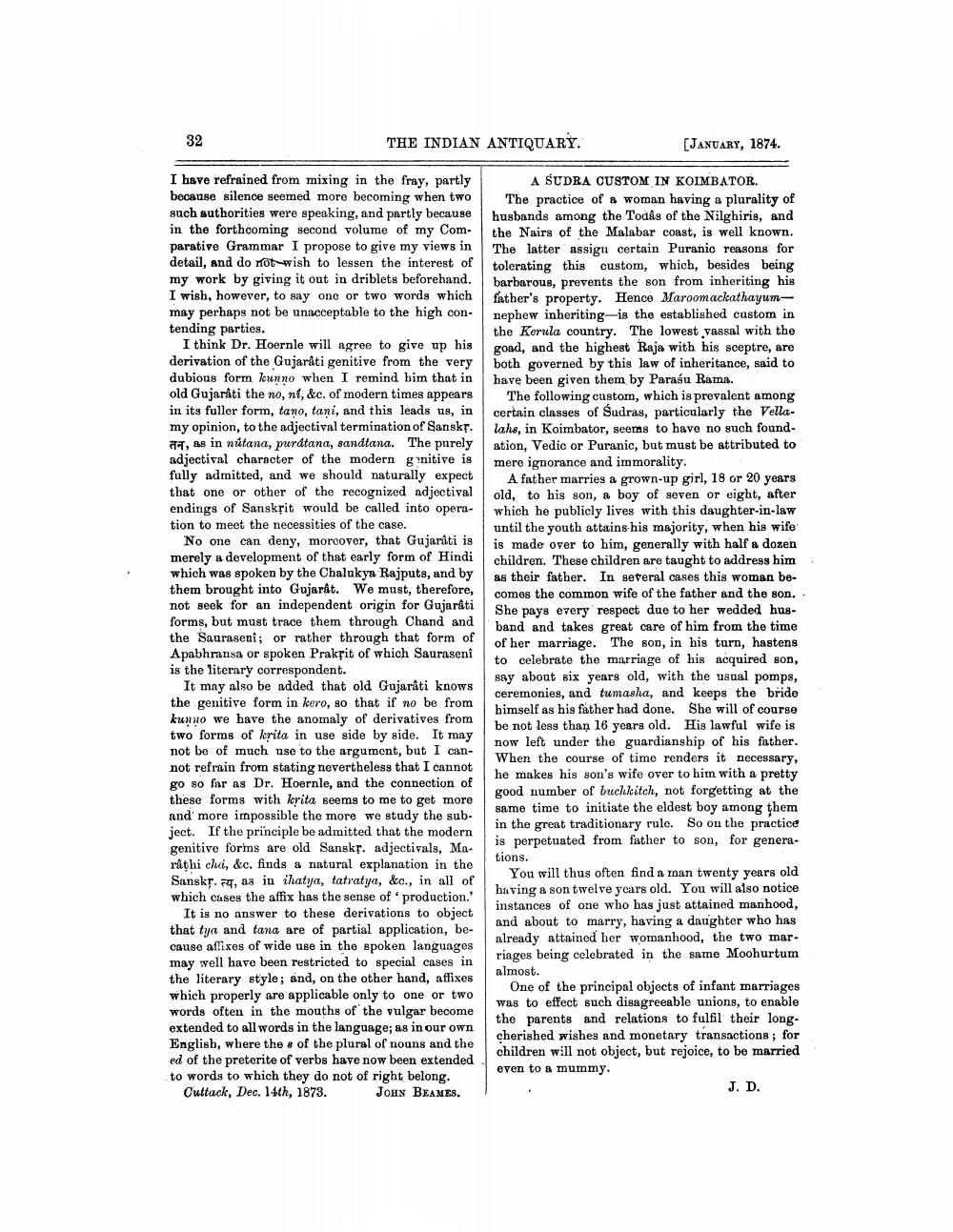________________
32
THE INDIAN ANTIQUARY.
I have refrained from mixing in the fray, partly because silence seemed more becoming when two such authorities were speaking, and partly because in the forthcoming second volume of my Comparative Grammar I propose to give my views in detail, and do not wish to lessen the interest of my work by giving it out in driblets beforehand. I wish, however, to say one or two words which may perhaps not be unacceptable to the high contending parties.
I think Dr. Hoernle will agree to give up his derivation of the Gujarâti genitive from the very dubious form kunno when I remind him that in old Gujarâti the no, nt, &c. of modern times appears in its fuller form, tano, tani, and this leads us, in my opinion, to the adjectival termination of Sanskr.
, as in nútana, purdtana, sandtana. The purely adjectival character of the modern genitive is fully admitted, and we should naturally expect that one or other of the recognized adjectival endings of Sanskrit would be called into operation to meet the necessities of the case.
No one can deny, moreover, that Gujarati is merely a development of that early form of Hindi which was spoken by the Chalukya Rajputs, and by them brought into Gujarât. We must, therefore, not seek for an independent origin for Gujarâti forms, but must trace them through Chand and the Sauraseni; or rather through that form of Apabhransa or spoken Prakrit of which Saurasenî is the literary correspondent.
It may also be added that old Gujarati knows the genitive form in kero, so that if no be from kunno we have the anomaly of derivatives from two forms of krita in use side by side. It may not be of much use to the argument, but I cannot refrain from stating nevertheless that I cannot go so far as Dr. Hoernle, and the connection of these forms with krita seems to me to get more and more impossible the more we study the subject. If the principle be admitted that the modern genitive forms are old Sanskr. adjectivals, Marathi chá, &c. finds a natural explanation in the Sanskr. 4, as in ihatya, tatratya, &c., in all of which cases the affix has the sense of production.'
It is no answer to these derivations to object that tya and tana are of partial application, because affixes of wide use in the spoken languages may well have been restricted to special cases in the literary style; and, on the other hand, affixes which properly are applicable only to one or two words often in the mouths of the vulgar become extended to all words in the language; as in our own English, where the s of the plural of nouns and the ed of the preterite of verbs have now been extended to words to which they do not of right belong. Cuttack, Dec. 14th, 1873. JOHN BEAMES.
[JANUARY, 1874.
A SUDRA CUSTOM IN KOIMBATOR.
The practice of a woman having a plurality of husbands among the Todâs of the Nilghiris, and the Nairs of the Malabar coast, is well known. The latter assign certain Puranic reasons for tolerating this custom, which, besides being barbarous, prevents the son from inheriting his father's property. Hence Maroomackathayumnephew inheriting is the established custom in the Kerula country. The lowest vassal with the goad, and the highest Raja with his sceptre, are both governed by this law of inheritance, said to have been given them by Parasu Rama.
The following custom, which is prevalent among certain classes of Sudras, particularly the Vellalahs, in Koimbator, seems to have no such foundation, Vedic or Puranic, but must be attributed to mere ignorance and immorality.
A father marries a grown-up girl, 18 or 20 years old, to his son, a boy of seven or eight, after which he publicly lives with this daughter-in-law until the youth attains his majority, when his wife is made over to him, generally with half a dozen children. These children are taught to address him as their father. In several cases this woman becomes the common wife of the father and the son.. She pays every respect due to her wedded husband and takes great care of him from the time of her marriage. The son, in his turn, hastens to celebrate the marriage of his acquired son, say about six years old, with the usual pomps, ceremonies, and tumasha, and keeps the bride himself as his father had done. She will of course be not less than 16 years old. His lawful wife is now left under the guardianship of his father. When the course of time renders it necessary, he makes his son's wife over to him with a pretty good number of buckkitch, not forgetting at the same time to initiate the eldest boy among them in the great traditionary rule. So on the practice is perpetuated from father to son, for generations.
You will thus often find a man twenty years old having a son twelve years old. You will also notice instances of one who has just attained manhood, and about to marry, having a daughter who has already attained her womanhood, the two marriages being celebrated in the same Moohurtum almost.
One of the principal objects of infant marriages was to effect such disagreeable unions, to enable the parents and relations to fulfil their longcherished wishes and monetary transactions; for children will not object, but rejoice, to be married even to a mummy.
J. D.




